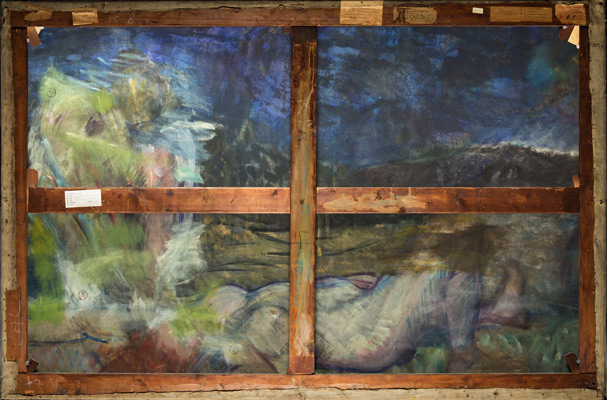As a child in Germany, Andrea von Hedenström had a print of German expressionist painter Franz Marc’s Grazing Horses IV hanging in her bedroom. Last fall, just after beginning a fellowship in the Straus Center for Conservation and Technical Studies, she was surprised to come face to face with the original 1911 work here at the Harvard Art Museums. And as if confronting a beloved icon from childhood weren’t enough, von Hedenström recently had the opportunity to work directly with the painting.
Over the past few months, she has been studying Grazing Horses IV in preparation for a loan to Germany’s Franz Marc Museum, which is hosting a trilogy of exhibitions of Marc’s works to commemorate the centenary year of his death. The artist was killed while serving in World War I at age 36.
Critical Work
Despite Marc’s untimely death, his works have enjoyed great success. Grazing Horses IV (also known colloquially as “Red Horses”) was the artist’s first painting to be acquired by a museum (Museum Folkwang in Hagen, Germany; it later was acquired by an American collector, who at first loaned and then gave it to the Busch-Reisinger Museum). In postwar Germany, reproductions of Grazing Horses IV were popular, and the painting came to be seen as a classic example of Marc’s colorful style.
Through intensive research, von Hedenström and Lynette Roth, the Daimler Curator of the Busch-Reisinger Museum, along with colleagues in the Straus Center’s analytical lab, are making new contributions to scholarship about the painting. Based on their analysis of Marc’s painting process, as well as of the materials he used, they theorize that he came into his own as an artist during the process of making Grazing Horses IV. They are also the first to interpret and publish images of the unfinished painting on the back of the work.
Colorful Investigation
Von Hedenström and Roth began by examining a description of the painting found in a letter from Marc to his later wife, Maria Franck:
For the terrain, pure vermillion alongside pure cadmium and cobalt blue, deep green and carmine red, the horses ranging from yellowish brown to purple. A very imposing, emphatically modeled setting; whole stretches of it (e.g., a bush) in the purest blue! Can you even imagine that?
In the Straus Center’s analytical lab, nearly every pigment in the painting was identified to determine if it matched up with Marc’s description and with early sketches. In most cases, it did.
The characteristic red horses in the completed painting, however, were obviously a departure from Marc’s initial aims of “yellowish brown to purple” horses. By comparing the completed painting to two (privately owned) tempera sketches with more subdued and natural color schemes, von Hedenström and Roth also noted that Marc’s colorful style was fully apparent only in his completed painting.
Compositional Changes
Von Hedenström noticed changes to the composition made during the painting process, a concept described as pentimento. A number of pentimenti, including a horse’s repositioned leg and variations in the landscape, are visible in raking light, in infrared light, and at the X-radiograph.
It’s not uncommon for artists to make alterations in the midst of their work, von Hedenström said, but “it’s always very interesting to find.” (The Harvard Art Museums collections contain even more dramatic examples of artists’ reworkings; Vincent van Gogh’s Three Pairs of Shoes, for instance, was painted atop a still life of flowers.)
Ilka Voermann, the Renke B. and Pamela M. Thye Curatorial Fellow, has helped von Hedenström share the research findings in gallery talks, including in the museums’ Lightbox Gallery. “From an art historical perspective, it’s fascinating to see how Marc worked, how many different decisions he made, and how many elements of the painting he changed while he was working on it,” Voermann said.
Revelations on the Reverse
The unfinished painting on the reverse of Grazing Horses IV was recently published for the first time in an essay by von Hedenström and Roth, in the exhibition catalogue accompanying the Franz Marc Museum exhibition trilogy. The painting depicts a reclining female nude in a shadowy landscape, with another figure perched on the ground near her.
Von Hedenström has found connections between the figures in this unfinished composition and two other works by Marc. In addition, the unfinished work’s cross-hatching, a technique Marc used to build up layers of paint, testifies to his intensive artistic process.
“It’s almost like a time capsule,” von Hedenström said. “You can see, for example, how parts of Grazing Horses IV might have looked before many layers of paint were added.”
Uncovering new perspectives like these has been edifying, von Hedenström said. “This type of research creates a basis for a deeper understanding of Marc’s techniques, and makes comparison with other works possible.”


